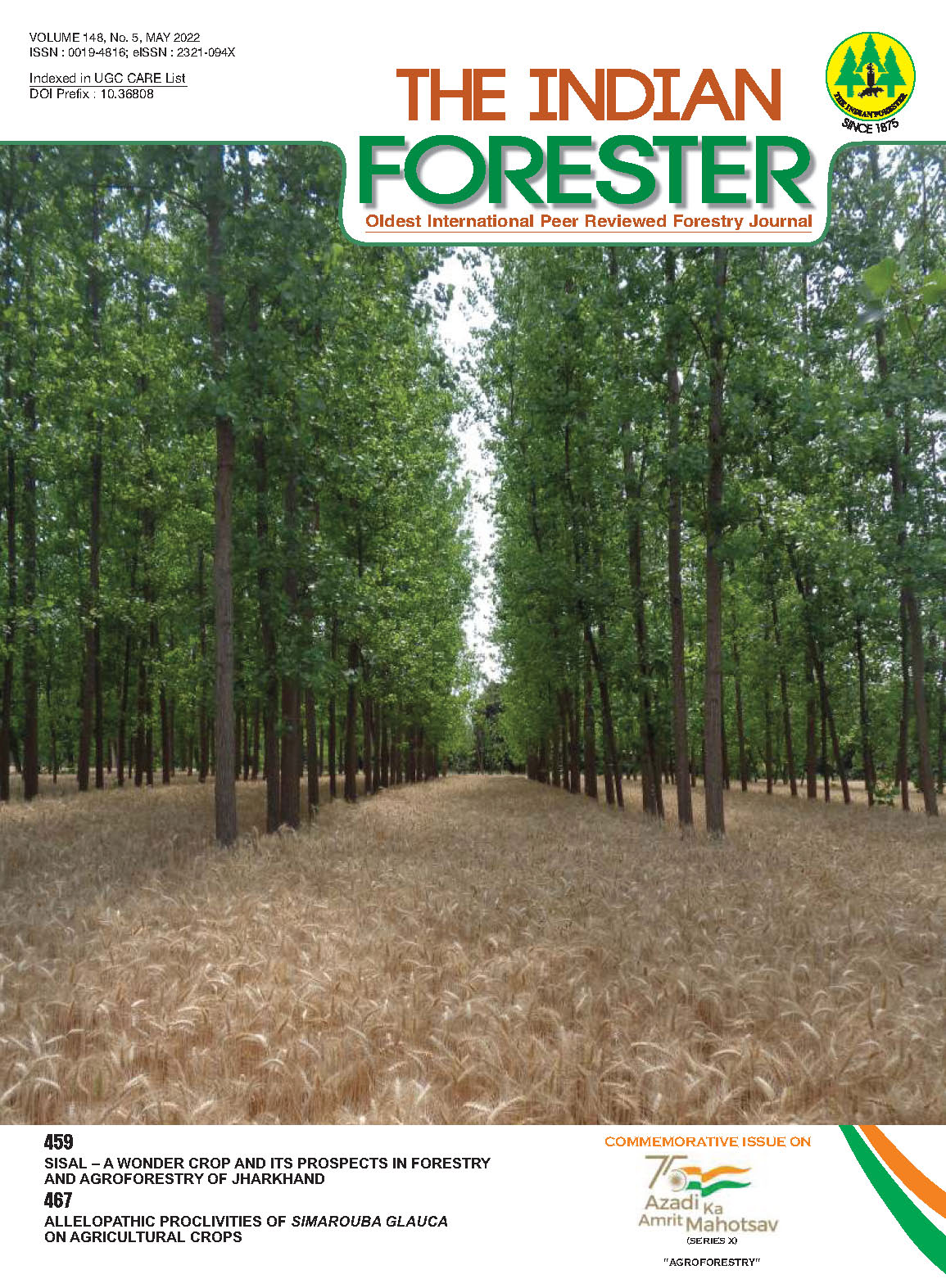Distribution and Diversity of Fodder Resources in Karnataka
DOI:
https://doi.org/10.36808/if/2022/v148i5/158245Keywords:
Fodder, Tree, Demand, Nutritive, Diversity, Agro climatic zone, KarnatakaAbstract
The livestock provide livelihood support to millions of people having small land holdings. However, the ever widening gap exists between demand and the actual supply of feed and fodder at the national level due to reduction of pasture, increase of livestock population and failure monsoon. The deficiency of feed and fodder is more conspicuous in arid and semi-arid regions. Foliage of trees and shrubs have been used as livestock fodder from time immemorial. Tree fodder contains high crude protein, minerals and has high levels of digestibility. Trees are introduced in the grazing and degraded lands to meet forage demand of livestock during the dry season. The present paper discusses fodder availability, its distribution, diversity, nutritive value and demand and supply in Karnataka.
References
Babu B.J, Siva Rao P.V.V.S., Rao C.C, Prasad E.V. and Murthy T.G.K. (2012). Fodder revolution in East Godavari district: an initiative by CTRI – KVK, New Image Graphics, Vijayawada 27.
Bhende M.J., R.S. Deshpande and Thippaiah P. (2004). Evaluation study of feed and fodder development under the centrally sponsored schemes in Karnataka. Agricultural Development and rural transformation (ADRT) unit, Institute for Social and Economic change, Nagarabhavi, Bangalore - 560 072.
Birthal Pratap (2000). Technological Change in India's Livestock Sector and Its Impact. In Pratap Birthal, Anjani Kumar and Laxmi Tiwari (eds.,) Conference Proceedings of Livestock in Different Farming Systems in India, Agricultural Economics Research Review: 13-35.
Bohra H.C. and Goyal S.P. (1986). Chemical detanning of Prosopis cineraria leaves. Presented at the 5th Animal Nutrition Workers Conference, Udaipur. Karnal: Animal Nutrition Society of India, July 14-17, 1989.
Business line (2020). Focus needed on fodder shortage in India, the Hindu, published on 28th April, 2020.
Gebremedhin W.K. (2015). Nutritional benefit and economic value of feeding hydroponically grown maize and barley fodder for Konkan Kanyal goats, IOSR Journal of Agriculture and Veterinary Science, 8(7): 24-30.
Gunasekaran S., K. Viswanathan and C. Bandeswaran (2014). Selectivity and palatability of tree fodders in sheep and goat fed by cafeteria method, International Journal of Science, Environment, 3(5): 1767-1771.
Gupta S.K., Pathak P.S. and Roy R.D. (1983). Biomass production of Sesbaniasesban Pers. on different habitats, My forest, (3): 145-155.
Kannan (2012). Economics of production, processing and marketing of fodder crops in Karnataka. Research Report: IX/ADRTC/142. Agricultural Development and Rural Transformation Centre Institute for Social and Economic Change.
Meena D.V.N., V.N. Ariharan and P.P. Nagendra (2013). Nutritive value and potential uses of Leucaena leucocephala as biofuel – a mini review, Research Journal of Pharmaceutical, Biological and Chemical Sciences, 4(1): 515-521.
Raj A.K., Kunhamu T.K., Jamaludheen V. and Kiroshima S. (2016). Forage yield and nutritive value of intensive silvopasture systems under cut and carry scheme in humid tropics of Kerala, India, Indian Journal of Agroforestry, 18(1): 47-52.
Sarvade S., Gautam D.S. Kathal D. and Tiwari P. (2017). Waterlogged wasteland treatment through agro-forestry: A review, Journal of Applied and Natural Science, 9(1): 44-50.
Satyanarayan K., Shilpa Shree J., Jagadeeswary V. and Lalith Achoth (2017). District-Wise Demand and Supply of Fodder (Crop Residues) Production in Karnataka – A Gap Analysis, International Journal of Livestock Research, 7(7): 123-131.
Singh R.V. (1982). Fodder trees of India. Oxford and IBH Publishing Co. 3-507.
Soni M.L., V. Subbulakshmi, N.D. Yadava, J.C. Tewari and J.C. Dagar (2016). Silvopastoral agroforestry systems: lifeline for dry regions in Agroforestry Research Developments (eds.) J.C. Dagar and J.C. Tewari, Nova Science Publishers, Inc. New York, 245-305.
Tewari J.C, Sharma A.K., Narain P. and Singh R. (2007). Restorative forestry and agroforestry in hot arid region of India: a review, Journal of Tropical Forestry, 23(I&II): 1-16.
Downloads
Downloads
Additional Files
Published
How to Cite
Issue
Section
License
Unless otherwise stated, copyright or similar rights in all materials presented on the site, including graphical images, are owned by Indian Forester.





